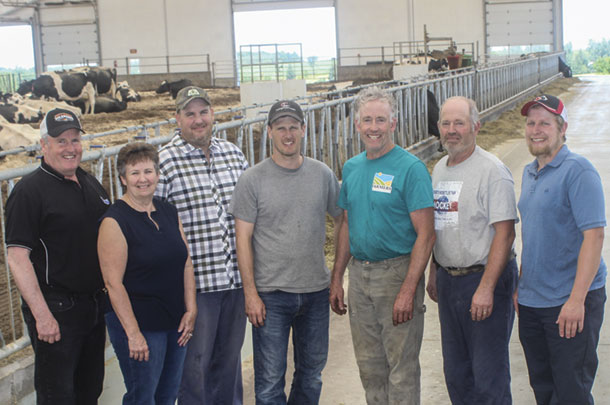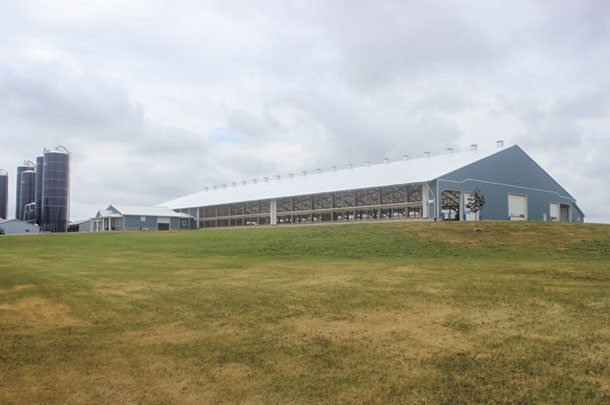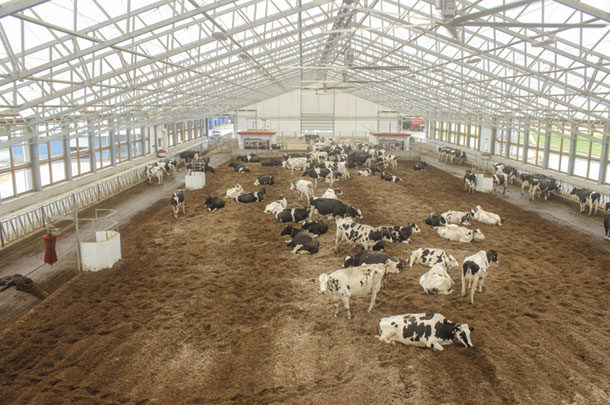Building a new dairy barn is no small feat. It takes careful consideration and planning, and it is often necessary to explore multiple options to determine what will fulfill farm needs the best.
This was the case for Highview Holsteins, the family-run farm near Port Perry, Ontario. Rose Evans says her husband, Neil, and their sons, Carl and Graig – who are co-owners of Highview Holsteins along with Neil’s brothers, Elden and Grant, and Elden’s son Justin – knew it was time to upgrade part of their tiestall operation and build a new barn.
In an effort to improve efficiency and milk production, Carl and Graig toured several nearby dairy facilities to find the barn style that would best suit their needs. With 40 Excellent and 96 Very Good classified cows in their herd, Carl says they wanted to prioritize cow comfort to maintain high classification. After looking at different barn options, Rose recalls, “They came back to us and said, ‘We need to go compost-packed because that is the best for cow comfort.’”
The decision to go with a compost-bedded pack offered many benefits. Carl says it keeps the cows clean and allows their larger-framed, older herd to rest comfortably without the need to lunge in stalls. Before committing to the new bedding, the family wanted to test it out first. “For two summers in a row, we did compost-packed in our Coverall, and it worked well,” Carl says.

It was a family affair when the Evanses decided what style of barn and bedding to transition to in their new build. Family members include (left to right) Neil, Rose, Carl, Graig, Grant, Elden and Justin Evans. Photo by Amanda Evans.
Along with the benefits to the cows, the compost-bedded pack offered more freedom in the structural design of the barn compared with other facility styles. Both Rose and Carl wanted to build a new barn that was free of large structural posts in the centre of the building. Rose says it was important to them to be able to easily manoeuvre the tractor in the barn. Carl says that minimizing the use of posts in the barn would alleviate concerns over the longevity of the posts. In order to create a barn with fewer posts, the Evanses decided to install milking robots and a WeCover fabric roof.
Rose says that together, the new elements of the barn offer flexibility. She says, “We like the cow freedom. They are not in a holding pen for long periods waiting to be milked. They will get up to be milked and, if the robots are busy, they can eat or use the cow brushes or get a drink.”

A fabric roof helps the Evanses keep their herd cool in the hot summer months and provides lots of natural light inside the barn throughout the year. Photo by Graig Evans.
The fabric roof provides a more naturally lit barn, which is something that drew the Evanses to it originally. Carl says, “We wanted to try to bring the outdoors indoors for the cows.” He describes the barn as a natural but controlled environment that allows the Evanses to still monitor their herd closely. He adds, “You can’t beat a fabric roof in the summer.” Rose and Carl agree that keeping the barn cool in the summer is much less of a challenge compared to their remaining, older tiestall barn, which they continue to operate, milking cows under a separate quota.
They say the hot air rises easily to the top of the 42-foot roof and allows for lots of air flow through the sidewalls. In addition to the air flow through the sidewalls, the barn is also fitted with six big fans down the centre. To Carl, the barn in the summer is akin to finding refuge under a large tree. He says, “I kind of describe it as when you’re under a nice maple tree in the summer and there’s a nice breeze and shade.” Rose mentions, “We find too that the butterfat doesn’t change because they don’t get the heat like our tiestall barn does.”
To create the base of the compost-bedded pack, the Evanses apply wood shavings to the barn floor, and a machine “stirs” the floor four times a day. Rose says they use 50 yards of shavings per week in the summer and 100 to 125 yards in the winter months, and that in the future they hope to use a half-and-half mixture of straw and shavings. Explaining the need for more shavings in the winter, Rose says, “You have to keep the moisture at a certain level for it to compost properly, so in the winter it’s wetter.” Ensuring the pack is not too wet helps prevent mastitis flare-ups.
The barn is then cleaned out once in spring and again in the fall, and the bedding is used as fertilizer in the Evanses’ fields. Rose says the new barn has meant less work overall. She says, “I know there’s less chores in this barn than there was before, but it is different.”
In addition to less work, Carl and Rose say the new barn has led to an increase in milk production. “Right now, we are probably [milking] 6 kilograms higher, per cow,” Carl says. Carl notes they have never pushed their herd to its production limits, but he is very happy with the results the barn has had on milk production, as he says they have not made any nutrition changes.
The Evanses say herd health has also changed for the better after transitioning to the new barn. “We are getting them calved quicker; the turnaround is just a lot better than the old barn,” Carl says. He also says the cows need to be treated less frequently, and they are having stronger heats. Rose adds the herd’s somatic cell count has dropped from 195,000 to 160,000, which she says is impressive for a compost-packed barn.
These health benefits are important, as Rose says 45% of the Evanses’ milking herd is 5 years or older. In 2019, they won an award from Holstein Ontario for an old cow, 14, in their herd who has been through 12 lactations and is entering her 13th.
The Evanses are happy with the results of their new barn, acknowledging that it was tough to learn a completely different management style. Carl says, “It was more of an adjustment for the people than it was for the cows.” He adds, “It’s a different way of farming, the technology and the robots. You kind of had to forget about your old ways in the new barn, and you kind of had to start again.”










